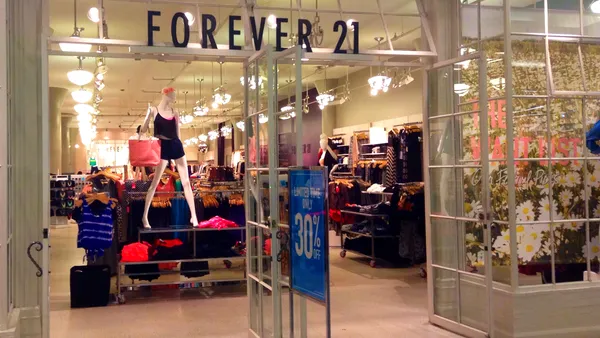Dive Brief:
-
Mobile commerce is expected to account for 34.5% of total e-commerce sales this year, and it's further anticipated to surpass 50% by 2021, according to eMarketer’s Mobile Commerce Roundup, a compilation of recent sector studies and articles.
-
About 60% of North American retail executives say their companies have a mobile web site, while more than half of the remaining 40% without one say they eventually will put one in place, according to a survey by Boston Retail Partners included in the report.
-
Regarding mobile apps, almost seven in 10 consumers in the U.S. access those apps to receive deals and offers. Nearly as many said they appreciate them for the flexibility to buy at any time from a retailer, according to a survey from B2B research firm Clutch also included in the report.
Dive Insight:
Mobile shopping is moving quickly toward the tipping point.
This compilation of indicators comes as Deloitte recently said it expects more than 50% of shoppers to dedicate their holiday shopping budgets to online shopping, with about 40% of consumers expected to at least use a mobile smartphone to access a retailer’s mobile shopping app during the holiday rush. Where online shopping is increasing, mobile shopping and purchasing isn’t far behind.
The Mobile Commerce Roundup also noted that according to the Boston Retail Partners study, 53% of retailers have created a mobile app and, more than half of the rest foresee building one. What’s curious is that not many of them — just 23% — are promoting in-store mobile offers on their mobile apps, although at least 40% said it’s something they’ll work on within two years. Retailers still need to improve at the mobile shopping game, and according to the study, many of them own up to that notion.
Meanwhile, the Clutch survey suggests customers are interested in those offers and deals via mobile, but perhaps not in-store. Clutch said consumers may embrace retailer apps in part because those apps appear to address problems with the experience of shopping in-store. Roughly half of the respondents said they wanted to see larger inventories, or save time at the store, or simply avoid going to the store. That might not be what some retailers want to hear, but it might be an invitation to integrate mobile offers with in-store experiences.
Mobile commerce has changed a lot over the last five years. Back in 2012, a quarter of online users were making purchases through their mobile devices, a figure that jumped to nearly two thirds by 2016, according to data from a study by The Integer Group.
This shift highlights the importance of shaping shopping experiences to the inclinations of mobile shoppers, according to the group. Integer's data is in line with eMarketer’s estimate that the total number of U.S. shoppers who made mobile purchases last year reached 136.3 million, or a little more than half of the total U.S. population ages 14 and older. Also, the volume of mobile commerce sales is expected to more than double between 2017 and 2020. Anticipated volume of $156.28 billion this year is expected to more than double to $336.98 billion in 2020.
The retailers and brands that have been in the mobile shopping game the longest and built up strong bonds with mobile customers will be in the best position to get the biggest piece of that particularly large pie.














